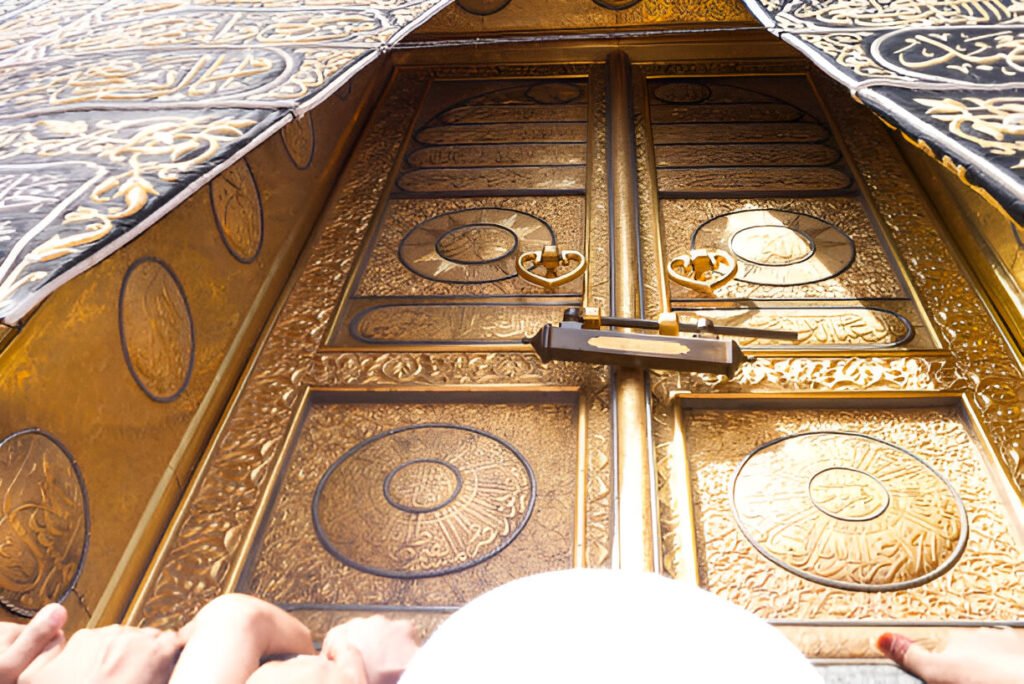Tradition, History, and Symbol of Sanctity The holiest place in Islam, the Kaaba, is not merely a structure for Muslims, but it is the center of spirituality. The door of the Kaaba, known as “Bab al-Kaaba,” is a very significant part of this sacred house. Its design, construction, and historical changes hold a special place in the history of Islam. This article will provide a detailed discussion on the door of the Kaaba.
The Early History of the Kaaba Door
The Kaaba was constructed by the first prophet of humanity, Hazrat Adam (A.S.). However, the current structure was reconstructed by Hazrat Ibrahim (A.S.) and his son Hazrat Ismail (A.S.). Before the advent of Islam, the door of the Kaaba was at ground level and made from ordinary wood.
When the Quraysh tribe rebuilt the Kaaba, they raised the door about seven feet above the ground. The main purpose behind this was to ensure the security of the Kaaba. This change not only made the Kaaba a symbol of sanctity but also turned it into a strategically secure place.
The Current Door of the Kaaba
In the year 1363 Hijri, King Abdul Aziz Al Saud installed a beautiful wooden door in the Kaaba, which took three years to complete.
The old door of the Kaaba was replaced in 1396 Hijri by King Khalid, who installed a golden door at that location. A total of 300 kilograms of pure gold, consisting of 99,999 types of gold, was used in the door. The name of Allah and verses from the Qur’an are inscribed on it. The door of the Kaaba now has two panels, with a lock in the center.
The Internal Door
The door of the Kaaba that we see externally also has another door on the right side inside. This is the internal door of the Kaaba. According to the year 1363 Hijri, or 1943 CE, King Abdul Aziz constructed this internal door. The internal door is named “Bab al-Tawbah” (The Door of Repentance). It also has a lock made of pure gold. This door, like the external door of the Kaaba, is an exquisite example of human craftsmanship. The intricate design surpasses human imagination. Both Bab al-Tawbah and Bab al-Kaaba are made from very strong wood, and gold is applied over them.
In the year 1397 Hijri, or 1977 CE, during the month of Jumada al-Awwal, King Khalid bin Abdul Aziz noticed that the internal door was deteriorating while performing prayers inside the Kaaba. He then ordered the door to be rebuilt, also made from gold, resembling the external door. Verses from the Qur’an are also inscribed on the internal door.
The Service and Key of the Kaaba
In Islam, serving the Kaaba is a distinguished task. This responsibility was historically assigned to a specific tribe, and Islam has recognized this service as the right of that tribe. In Arabic, this service is called “Hijābah” (الحجابة), and those who perform it are called “Sādah al-Ka’bah” (سَدَنَهُ خُدامُ الكعبة). The Banu Shaybah tribe is the custodian of the Kaaba. They hold the key to the Kaaba and are responsible for its protection. The Prophet Muhammad (PBUH) confirmed them as the heirs of this service. On the day of the conquest of Makkah, he took the key of the Kaaba from them, opened the door of the Kaaba, and removed the idols inside. Then he returned the key to the Banu Shaybah tribe, saying, “Take it, O Banu Abd al-Dar, to remain with you forever until the Day of Judgment. No one will take it from you except an oppressor.”
The Kiswa of the Kaaba
The Kiswa, or the covering of the Kaaba, is handed over to the Banu Shaybah tribe as well. Later, it was installed on the Kaaba.
Modern Arrangements for the Preservation of the Key
Today, modern technology and security systems have been implemented for the preservation of the key of the Kaaba. The key is kept in a specially secured location, and the custodians of the key perform their duties with the utmost care and caution.
Role of the Saudi Government
The Saudi government honors the role of the Banu Shaybah tribe as the custodians of the Kaaba key. They provide all necessary support to ensure the continuation of their tradition.
Preservation of the Key
The key is kept in a special room or storage area where it remains secure. It is only taken out for use during specific times or special occasions.



